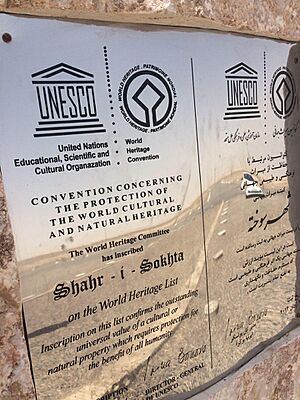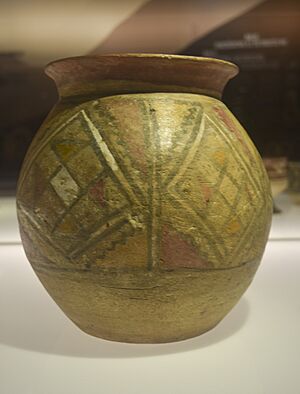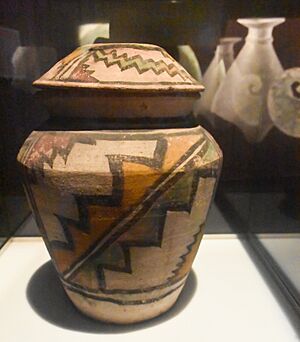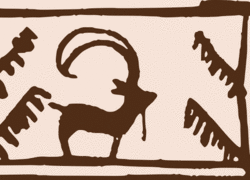Shahr-e Sukhteh facts for kids
|
شهر سوخته
|
|
 |
|
| Location | Sistan and Baluchestan Province, Iran |
|---|---|
| Region | Sistan |
| Coordinates | 30°35′43″N 61°19′35″E / 30.59528°N 61.32639°E |
| History | |
| Founded | 3550 BC |
| Abandoned | 2300 BC |
| Periods | Late Chalcolithic, Bronze Age |
| Cultures | Helmand culture |
| Site notes | |
| Condition | In ruins |
| Public access | yes (08:00–19:00) |
| Official name | Shahr-i Sokhta |
| Type | Cultural |
| Criteria | ii, iii, iv |
| Designated | 2014 (38th session) |
| Reference no. | 1456 |
| Region | Asia-Pacific |
Shahr-e Sukhteh (Persian: شهر سوخته, meaning "Burnt City") was a large city from the Bronze Age, around 3550 to 2300 BC. It is linked to the Helmand culture. You can find this ancient site in the Sistan and Baluchistan Province in southeastern Iran. It sits on the bank of the Helmand River, close to the road between Zahedan and Zabol. In June 2014, UNESCO added it to its World Heritage List.
It's still a mystery why this city suddenly grew and then disappeared. The items found here are quite different from those of other nearby ancient groups. Some people think Shahr-e Sukhteh might show that a civilization in eastern ancient Iran developed on its own, separate from ancient Mesopotamia.
Contents
Discovering the Burnt City
How did we find out about Shahr-e Sukhteh? The site was first found and looked into by Aurel Stein in the early 1900s. Later, in 1967, a team from Italy, led by Maurizio Tosi, started digging there. They worked until 1978. After a break, Iranian archaeologists, led by S.M.S. Sajjadi, continued the work in 1997. New discoveries are still being made!
What Was Shahr-e Sukhteh Like?
How big was this ancient city and where was it located? Shahr-e Sukhteh was once thought to cover about 151 hectares (about 373 acres). But now, we know it was even bigger, covering about 200 hectares (about 494 acres). The built-up area was around 120 hectares. This makes it one of the largest cities in the world when cities first began to appear.
Today, the city is near the edge of the Lut desert, which is one of the hottest places on Earth. However, in ancient times, the weather was much nicer. The Hamun Lake, which was close to the city, was much larger. There were also many marshlands around. Another important ancient site, Dahan-e Gholaman, is only 50 km (about 31 miles) away.
In the southwestern part of Shahr-e Sukhteh, there's a huge graveyard. It covers about 25 hectares (about 62 acres) and might hold between 25,000 and 40,000 ancient graves!
The City's Story: Rise and Fall
What happened during the different periods of Shahr-e Sukhteh? The city started around 3550 BC. Experts believe it went through four main stages of development. It was also burned down three times before people finally left it. At first, archaeologists thought the city was abandoned around 1800 BC. But newer research suggests it was left around 2300 BC.
Early Days: Period I (3550–3000 BC)
In its earliest time, Shahr-e Sukhteh already had strong connections with other places. These included sites in southern Turkmenistan, the Kandahar region of Afghanistan, and parts of Iran like the Bampur valley. It also had links to early cities in Proto-Elamite areas. Pottery from this time often had light colors and rich designs. Some pottery was even imported from places as far as Turkmenistan (750 km away) and Pakistan (400-500 km away). Around 3000 BC, a big fire destroyed most of the city.
Growing Stronger: Period II (3000–2600 BC)
After the fire, the city was rebuilt, though some destroyed houses were not. During this time, Shahr-e Sukhteh also connected with early cities in the Indus Valley. The city grew much larger, reaching about 80 hectares. It seems that Shahr-e Sukhteh and Mundigak (in Afghanistan) were very close. Their strong ties led experts to talk about a "Helmand Civilization." Pottery became more advanced, using better materials and firing methods. Later in this period, pottery became simpler, and burials showed that people had different levels of wealth.
Peak Times: Period III (2600–2400 BC)
During this period, large buildings with thick walls continued to be built. Pottery became more standardized, losing the fancy designs of earlier times. Trade and connections with Mundigak, Bampur, and the Indus civilization continued. Many colorful pots were found in the graveyards, possibly used in religious ceremonies. Some experts think these colorful pots were brought in from other places, but others believe they were made locally.
Final Years: Period IV (2400–2300 BC)
This period is known from the "Burnt Palace" or "Burnt Building." During this time, Shahr-e Sukhteh mainly had contacts with the Bampur valley and the Kandahar area. Workshops were found where people processed materials like flint, lapis lazuli, and turquoise. These workshops are special because they are unique in the region. Archaeologists found signs that the city was abandoned around 2350 BC. Some experts believe this was the last time the city was a busy urban place.
Later Inhabitants: Period V (2100–2000 BC)
After the city was abandoned around 2350 BC, some parts of it, like the "Burnt Building," were lived in again around 2100–2000 BC. However, this might have been just a small group of people, as the main city life had already ended. The "Burnt Building" itself was destroyed by a big fire around 2000 BC.
Parts of the Ancient City
What were the different areas within Shahr-e Sukhteh? The city of Shahr-e Sukhteh was divided into five main areas:
- The Eastern Residential Area: This was the highest part of the site, where people lived.
- The Great Central Area: Also called the Central Quarters, this area was separated by deep dips in the ground. A special place here was known as the "House of the Jars."
- The Craftsman Quarters: This part of the city was in the northwest. Here, skilled workers likely made different goods.
- The Monumental Area: Located east of the Craftsman Quarters, this area had several tall hills that were once important buildings. Some pottery ovens were found nearby, but most pottery was made outside the town.
- The Graveyard Area: Also known as the Cemetery, this huge area in the southwest covers about 25 hectares. It's estimated to have between 25,000 and 40,000 graves. Most burials are from the early periods of the city.
Amazing Discoveries from Shahr-e Sukhteh
What cool things have archaeologists found here? Many incredible items have been found at Shahr-e Sukhteh, showing how advanced this ancient civilization was:
- The First Animation? An earthen goblet (a type of cup) found here, from around 3178 BC, has a series of images. Some archaeologists think these images, when spun, create what might be the earliest known animation!
- An Ancient Artificial Eye: In 2006, archaeologists found the earliest known artificial eye in the burial of a woman. It was made of a light material, possibly bitumen paste, and covered with a thin layer of gold. It had a central circle for the iris and gold lines like sun rays. Tiny holes on the sides suggest a golden thread held it in place. The woman, who was unusually tall for her time (1.82 m or 6 feet), likely wore this eye throughout her life. Her skeleton dates to between 2900 and 2800 BC.
- The Oldest Complete Board Game: The oldest complete board game ever found was unearthed here. It came with 4 different dice and 27 geometric pieces. What makes it special is that it's the earliest known example of a "twenty square game" with all its parts. This helps us understand the history of board games.
- Brain Surgery: A human skull found at the site shows signs that brain surgery was performed there long ago.
- Unique Marble Cup: A special marble cup was discovered in December 2014.
- Decorated Leather: A piece of leather with drawings on it, from the Bronze Age, was found in January 2015.
Ancient Health Clues
What can we learn about health in Shahr-e Sukhteh? Studies of ancient parasites suggest that people living in some parts of the city were infected by a rare type of worm called Physaloptera.
Connections to Other Ancient Cultures
How was Shahr-e Sukhteh linked to other civilizations? The civilization of Shahr-e Sukhteh thrived between 3200 and 2350 BC. This time might have overlapped with the early growth of the great Indus Valley civilization. The later periods of Shahr-e Sukhteh are similar in time to parts of the Mature Harappan period of the Indus Valley.
Shahdad is another large ancient site being dug up that is connected to Shahr-e Sukhteh. In the Sistan Basin, a desert area between Afghanistan and Pakistan, about 900 Bronze Age sites have been found.
See also
- Sistan Basin
- Cities of the Ancient Near East
- Mundigak
- Proto-Elamite script











